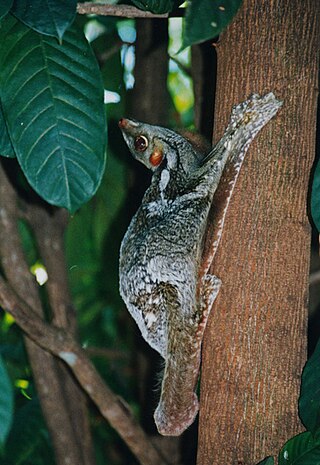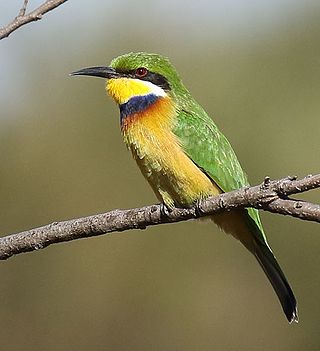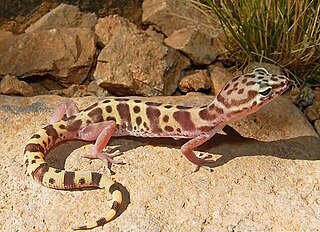
Colugos are arboreal gliding mammals that are native to Southeast Asia. Their closest evolutionary relatives are primates. There are just two living species of colugos: the Sunda flying lemur and the Philippine flying lemur. These two species make up the entire family Cynocephalidae and order Dermoptera.

Coleonyx is a genus of terrestrial geckos commonly referred to as banded geckos. Species of Coleonyx are found in the southwestern United States, Mexico, and Central America. Most banded Geckos enjoy dry, warm weather which is why they are typically found in the Peninsular Desert. Some, however, prefer humid forests. They are relatively small lizards, measuring about 5–6 in (13–15 cm) inches in total length. They are nocturnal and are found primarily in dry, rocky habitats. Banded Geckos have preyed by snakes, their main predators being rattlesnakes and glossy snakes. Banded Geckos can decipher how they should react when they obtain a chemical cue based on their knowledge of the predator. A main resource they use to distract the predator is losing their tail or escaping quickly. Banded Geckos possess heteromorphic euchromatic sex chromosomes which play a large role in their historical contingency.

Lumbriculus variegatus, also known as the blackworm or California blackworm or Australian Blackworm, is a species of worm inhabiting North America Europe and Australia. It lives in shallow-water marshes, ponds, and swamps, feeding on microorganisms and organic material. The maximum length of a specimen is 10 cm (4 in). Worms raised in laboratory environment are slightly shorter, with 4 to 6 cm long bodies. An adult individual has approximately 150 to 250 1.5 mm wide segments, each of which has the ability to regenerate into a new individual when separated from the rest of the animal. In most populations, this is the primary mode of reproduction, and mature individuals are exceedingly rare; in large areas mature individuals have never been found. The name blackworm is given to at least three distinct species of worm that are identical in appearance and were once considered a single species.

The Sunda flying lemur, also called Malayan flying lemur and Malayan colugo is the sole colugo species of the genus Galeopterus. It is native to Southeast Asia from southern Myanmar, Thailand, southern Vietnam, Malaysia to Singapore and Indonesia and listed as Least Concern on the IUCN Red List. Although it is called "flying lemur", it cannot fly but glides among trees and is strictly arboreal. It is active at night, and feeds on soft plant parts such as young leaves, shoots, flowers, and fruits. It is a forest-dependent species.

The blue-breasted bee-eater is a central African species of bird. It is a member of the family Meropidae. Meropids are all visually similar and have a diet specialized in Hymenopterans.

The scaly-throated honeyguide is a species of bird in the family Indicatoridae. They have a mutualistic relationship with humans in which they attract beekeepers towards bees' nests and then feeding on the remains, especially larvae.

The rock squirrel is a species of rodent in the family Sciuridae. It is native to Mexico and the Southwestern United States, including southern Nevada, Utah, Colorado, Arizona, New Mexico, West Texas, and the panhandle of Oklahoma.

The western banded gecko is a species of lizard in the family Eublepharidae. The species is native to the southwestern United States and adjacent northwestern Mexico. Five subspecies are recognized.

Lytechinus variegatus, commonly called the green sea urchin or the variegated sea urchin, is a species of sea urchin that can be found in the warm waters of the western Atlantic Ocean and Caribbean Sea.

Mesosini is a tribe of longhorn beetles of the subfamily Lamiinae.

Planodes is a genus of longhorn beetles of the subfamily Lamiinae, containing the following species:
Planodes annamensis is a species of beetle in the family Cerambycidae. It was described by Stephan von Breuning in 1957.
Planodes johorensis is a species of beetle in the family Cerambycidae. It was described by Stephan von Breuning in 1936.
Planodes longemaculatus is a species of beetle in the family Cerambycidae. It was described by Stephan von Breuning in 1960, originally as Planodes longemaculata. It is known from the Philippines.
Planodes ambonensis is a species of beetle in the family Cerambycidae. It was described by Stephan von Breuning and Chûjô in 1965.
Planodes deterrens is a species of beetle in the family Cerambycidae. It was described by Francis Polkinghorne Pascoe in 1865. It is known from Malaysia and Borneo.
Planodes leporinus is a species of beetle in the family Cerambycidae. It was described by Francis Polkinghorne Pascoe in 1865. It is known from Borneo.

Planodes denticornis is a species of beetle in the family Cerambycidae. It was described by Chevrolat in 1858.
Planodes quaternarius is a species of beetle in the family Cerambycidae. It was described by Newman in 1842. It is known from the Philippines.
Planodes is a genus of flowering plants belonging to the family Brassicaceae.










